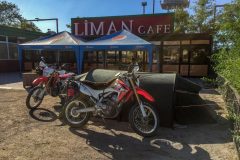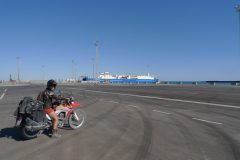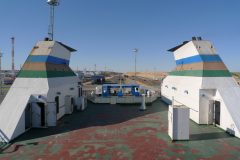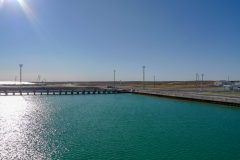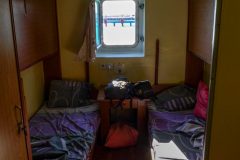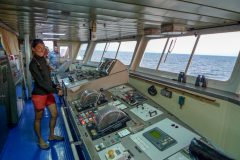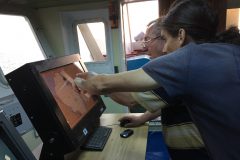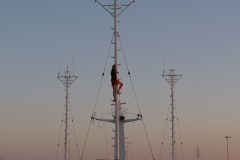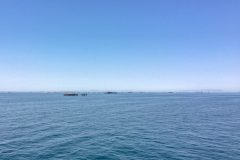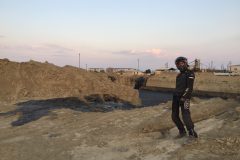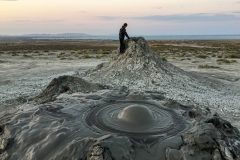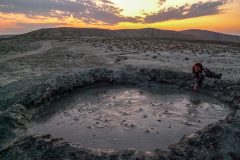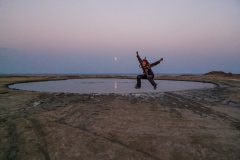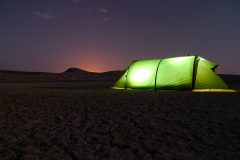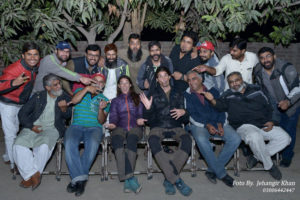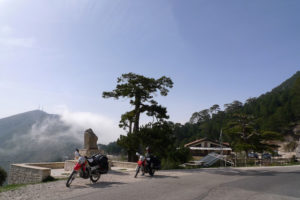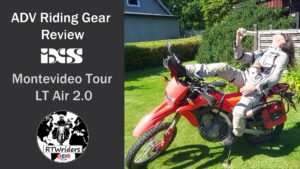Kazakhstan and Kyrgyzstan are part of a russian economic zone, so the border crossings and customs at these countries were always uncomplicated and fast. However Tajikistan isn’t part of that zone and we now have to re-enter Kazakhstan. So we expect to have an effortful border crossing again, like we already experienced while entering Russia.
The western border in Uzbekistan is at the back of beyond. There is absolutely nothing, the street almost ends anyway and it is super boring. Nobody is passing this border, except of people, that want to go to Aktau – means people living or working there, or persons that want to catch one of the caspian ferries. The departure is straightforward and the border guards are once again very friendly. To our surprise everything goes very quickly and uncomplicated on the Kazakh side, too. We don’t have to fill out a single piece of paper, everything is digitally settled for us in a very short time and half an hour later we are already back to Kazakhstan.
The road to Beinu after the border is a construction site. It will be completely renewed in future, but it is not finished yet. So we still have to ride on the dusty gravel road next to it. There are many trucks and it is extremely dusty. Very often we can hardly see anything. The only creatures, that seem to be untouched by this chaos, are a few camels next to the track, staring at us with big googly eyes.
After Beinu the road condition is good, but the landscape remains barren until Aktau. Shortly before Aktau you can see countless oil production stations and more and more industrial plants appear. This area is by far one of the most hideous we have ever seen. We don’t even drive into Aktau and ride straight to the ferry port instead. There is a small ticket booth at the harbour and we try to find out when and where the next ferry will leave. The problem with the Caspian ferries is, that there is no fixed timetable. The ferries leave whenever they are fully loaded and the weather is alright.
There are also two ports where ferries depart, but nobody at the ticket counter can give you informations, which one will be the place, where the next ferry is leaving from. We are only assured, that there will be no ferry today – maybe tomorrow or maybe next week. Luckily a small cafe is situated close to the ticket booth. Since it is already getting dark, we eat a snack there and ask, if we could pitch our tent on the parking lot. To our surprise this is not a problem at all. We are even supposed to settle a bit closer to the video cameras for maximum security and to be in range for a free WiFi zone.
The next morning we try to get updated informations at the ticket counter. Once again we are told “certainly not today”, but the next ferry will most likely leave at the new port about 70 kilometers south of Aktau. Since there is nothing else to do anyway, we decide to ride to the other port and set up our camp there. We don’t feel like we are in a hurry. So we take our time, order breakfast, apply for our online visas for Azerbaijan and we are even allowed to use the shower in the cafe.
When we leave the harbour district, we meet a British couple on a motorcycle and they finally follow us straight to the new harbour in Kuryk. The port in Kuryk is difficult to find. It is not directly in the village itself, which is already situated in the middle of nowhere, but about 20 kilometers outside. You have to take a gravel road through the desert to reach the surprisingly modern port. It is equipped with English lawn everywhere and looks really great until you notice, that it is all artificial turf – it would also be extremely inconvenient to water.
As we enter the passenger building, we are surprised to meet waiting tourists there. Suddenly we get informed, that we should quickly buy our tickets, the ferry is going to leave soon. So much for the reliability of the statements at the ticket counter in Aktau. We were really lucky, otherwise we would have waited several days for the next ship. By the time all customs matters have been resolved, which takes half an eternity, “Professor Gul” is already fully loaded and is just waiting for us to cast off. The weather is good and there should be no delays.
Professor Gul is 30 years old. We are told, that ships usually need to be completely restored after 10 years. The Kazakh government believes that Professor Gul still doesn’t need it after 30 years. Cool – it still floats, the engine runs and actually it doesn’t look too bad for its age – we head towards Baku.
We have read a lot of bad reviews about this ferry line. However we don’t know what other travellers have in mind, but we think the sleeping cabins are perfectly fine. We get three meals that are not a treat, but ok. There are hardly any people on the ferry. It is actually not a passenger ship, but primarily transports freight wagons. The crew is pretty cool though and they seem to be happy to have some variety with travellers on board. You can even take photos on the bridge with the captain and the crew. After dinner we are officially invited to the bridge, get all the instruments explained and are allowed to inform us about everything.
The next afternoon we reach the port of Alat south of Baku after having passed countless oil platforms. Many of the platforms are already out of order and are gradually being eaten up by the salt water. The sight is not nice, but let’s call it interesting. The entry to Azerbaijan is straight forward. The big evil here seems to be drones and every customs officer asks us about ten times. They are all very friendly, but they investigate our luggage and are only satisfied after they are sure, that we don’t bring a drone. For any reason they find it very strange, that people carry rice, lentils and pasta. After we have paid a fee for our motorbikes, we are ready to leave the port zone.
We have a snack at a gas station after we have managed to persuade the staff, that we only can pay for our food in US dollars. There is no reason for us to withdraw Azerbaijani money, since we are already going to leave to Iran the next day. We have no desire to go to Baku and decide to rather visit a place with mud volcanoes nearby. When we leave the highway on the small gravel road, it smells of oil everywhere. A few meters further we know why. It seems like oil is just spilling out of the ground here. Until we reach the mud volcanoes, we pass several such places in the desert – no wonder it is such a rich country.
The area with the mud volcanoes is ideal for pitching our tent. In many places cold mud bubbles in small mini volcanoes or in pools. The whole scenery is particularly mystical with the starry sky and moonlight. After a good night’s sleep with soothing bubbles, we drive to the Iranian border in Bilarsuvar the next morning. We choose the small border crossing instead of driving to the large border in Astara, to try to avoid an expensive motorcycle insurance people sometimes get charged for.

